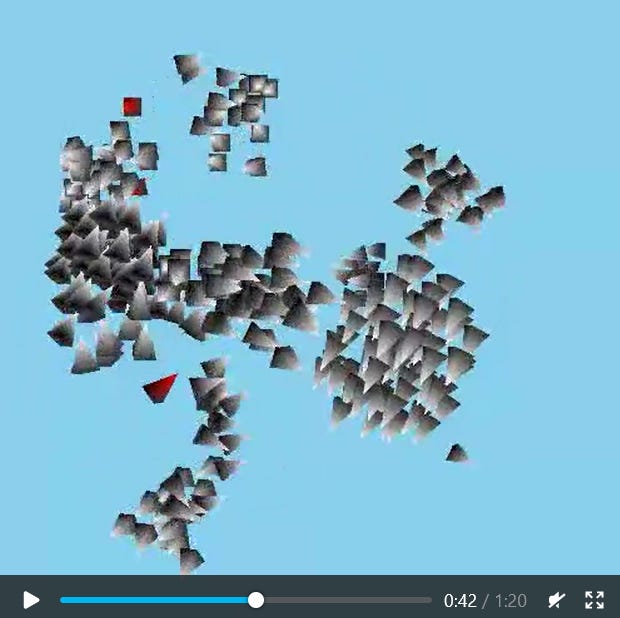Is the democratic world too complex for a system-level con?
Or perhaps, like Yuval Noah Harari, we have the wrong metaphor of complexity?

For the want of a nail the shoe was lost,
For the want of a shoe the horse was lost,
For the want of a horse the rider was lost,
For the want of a rider the battle was lost,
For the want of a battle the kingdom was lost,
And all for the want of a horseshoe-nail.
— Benjamin Franklin
“Some people believe that there is somebody in charge after all. Not democratic politicians or autocratic despots, but rather a small coterie of billionaires who secretly run the world. But such conspiracy theories never work, because they underestimate the complexity of the system.”
— Yuval Noah Harari
Can an ostensibly democratic system—keeping the appearance of freedom—be managed with centrally and clandestinely organized corruption?
No, some say, because that would require managers to predict the ‘butterfly effects’ of relatively gentle nudges on the whole system—and that is impossible.
But perhaps the ‘butterfly effect’ is the wrong metaphor.
Whoever proposes that an entire democratic system has been conned is putting forth a Machiavellian hypothesis of the kind usually tagged ‘conspiracy theory.’ No such proposal can prosper in the modern Western university, where the taboo on conspiracy theory is a paradigm.
What does that mean?
As philosopher of science Thomas Kuhn famously explained, your paradigm is your dogma: fully embodied and internalized, mostly implicit and intuitive, and self-evident to you. You feel zero need to defend or justify it. If someone challenges, that’s ‘absurd’ or ‘crazy.’
That doesn’t mean you are wrong, mind you. You might be right. But you don’t know why, because, if challenged, you dismiss rather than engage.
Many who believe that evolution by natural selection explains the structure of our biological world, for example, simply dismiss creationists, though they themselves can neither explain Darwinian theory nor answer sophisticated creationists who make arguments and invoke evidence. That doesn’t mean the creationists are right (I don’t think they are). It just means that Darwinism, for many, has become a paradigm.
(I should clarify that I believe Creationists are right to posit some kind of Act of Creation, but I believe they are wrong to take the Bible literally as a historial account, which forces them, absurdly, to try and defeat the validity of Darwinian theory.)
The conspiracy-theory taboo—the social dynamics of which I discuss elsewhere—is a paradigm in the Western university. Thus, university professors feel zero need to present theory-based justifications or evidence when reflexively (and sometimes emotionally) sweeping a Machiavellian hypothesis from the table for the lonely sin of belonging to the category.
If and when professors do bestir themselves, they often claim that the democratic world of markets and plural politics is too complex for system-wide Machiavellian efforts to succeed. Thus, world-famous history professor Yuval Noah Harari:
“Some people believe that there is somebody in charge after all. Not democratic politicians or autocratic despots, but rather a small coterie of billionaires who secretly run the world. But such conspiracy theories never work, because they underestimate the complexity of the system.”1
Good. At least that’s an argument.
And it’s from Harari, whose first blockbuster, Sapiens, published in 2015, sold 1 million copies by 2017. That’s just the first two years—of the English edition (the work has been translated into 65 languages, according to Wikipedia.) And that’s just his first blockbuster! (He’s had other, similar successes.) Everybody seems to agree that Harari is smart. He seems like a worthy opponent.
As my first step, I’ll make Harari even stronger: I’ll ‘steel man’ his presentation. Only then will I defend an alternative view.
‘Complexity’—a few basics
Harari’s dismissal of system-wide conspiracy theories rests on intuitions based on the science of ‘complex systems’ that I must first unpack before I can make the strongest case—explicitly—for his argument. So bear with me (this will be worth it).
Any conversation involving ‘complex systems’ and ‘complexity theory’ will likely make reference to the properties of ‘emergence,’ ‘self-organization,’ and ‘chaos,’ which are employed to make statements about the relationship between the whole system and its parts.
Here is one example of what is meant by emergence:
“A striking example of collective motion in the animal world is to be seen at dusk above the treetops, as flocks of starlings swoop and dive this way and that in near-miraculous close formation. …[N]o individual is calling the shots—there is no leader. Yet every bird seems to make the same decision at the same time.”2

Our minds effortlessly interpret the moving starling flock as a coherent whole. As the starlings “swoop and dive” we perceive lightning-quick ‘vibrations’ that ‘travel’ the length of the ‘whole’ and alter its ‘shape.’ This image is all we need to get our intuitive bearings on the concept of emergence.
A complex system exhibits emergence when all of the following are true:
the system displays properties or patterns at the system level—that is, when viewed as a whole—that result from the interactions among the parts; but
you cannot find those properties or patterns in the individual parts themselves; they only manifest—or have meaning at—the system level; and
the system-level patterns occur without any ‘intention’ of the parts, or, to speak more generally (and less metaphorically), without any top-down or executive management (the parts spontaneously ‘self-organize,’ as they say).
Now consider a contrasting case.
Consider what—in relative slow motion—sports fans all over the world now do: the Mexican wave (so-called because it apparently first appeared during the 1986 FIFA World Cup in Mexico). The Mexican wave has some obvious similarities to a starling flock: ‘vibrations’ seem to ‘travel’ the length of the ‘whole’ population of fans. But there are some important differences.

For starters, a stadium ‘wave’ is purposeful behavior by creatures fully aware of the system-level pattern they wish to bring about and observe: the human parts of the stadium-audience system are collectively trying to make that precise wave. So a stadium wave—unlike a starling flock—is, indeed, governed behavior.
The stadium wave doesn’t have much in the way of executive management. It does have an original leader: the person who coaxes those nearby to rise in unison and ‘start a wave.’ But the wave property of the stadium-audience system can easily peter out anywhere once it has begun. Yet there is no denying that this process is entirely conscious and intended, and it is diffusely managed by the conscious participants themselves.
The system-level shapes that starling populations collectively make as they fly are, to the contrary, ungoverned, unmanaged, and unconscious. It is these three properties that label the system-level shapes in a starling system as ‘emergent.’
How do these shapes emerge?
Craig Reynolds, a software engineer, has created graphic representations of individual birds, called ‘boids’ (bird + droid), where each was programmed to mind only its ‘local sphere’ containing its immediate neighbors:
“each boid would try to match its speed to the average speed of others within its local sphere; it would move toward the center of mass of this group; and it would avoid collisions with others.”3
And that does it! Reynold’s boids, programmed in this manner, produce patterns strikingly similar to those of starlings.

The system-level ‘shapes’—folding and opening, twisting and turning, rising and diving—that human observers of flying starlings delight in, quite impossible to predict, are not specifically desired by any individual in a starling flock; they result from the unconscious local actions of near-sighted individuals following very simple rules, leading spontaneously—without top-down or executive management—to large-scale, coherent, system-level behavior: emergence.
Many human systems are more like starling flocks than stadium wavemakers. For example, drivers on Mexico City freeways. Traffic patterns on freeways—which lack traffic lights—are entirely the consequence of individual drivers reacting locally, like starlings, to their immediate neighborhood. Though caused by the drivers, the patterns are not—as such—willed by them or anyone else; they are emergent.

In such systems the rules of thumb that guide the moment-to-moment decisions of individuals are analogous to laws of physical nature governing the interactions of inanimate matter. One may therefore usefully model such systems as if they were composed of dumb ‘atoms,’ applying to them the mathematical tools of statistical physics. Statistical physics is known to many by the trendier term ‘complexity theory.’
One of the basic findings in this branch of research is that, in complex systems, tiny changes anywhere among the parts can have huge differences at the system level. If a speck of dust collides with the left eye of starling X, causing it to move just a bit more to the left than it otherwise would, the starlings immediately around it will adjust their vectors, and such adjustments will then propagate and amplify, yielding a system-level shape that may be radically different from what the flock would otherwise have done if starling X hadn’t overreached.
This property is often discussed in the context of so-called ‘chaos’: non-linear systems with non-random yet unpredictable dynamics.
An example of a chaotic system is turbulence, which happens in moving fluids in a very broad range of conditions. Billowing smoke coming out of a chimney, say. Indeed, almost any kind of movement of air in our atmosphere is turbulent. Weather is therefore turbulent.

Edward Lorenz gave us the metaphor that everyone now uses to think about turbulent weather systems: the ‘butterfly effect.’
One version of that metaphor goes like this: a giant Pacific storm emerges—or not—on the American coast depending on whether a butterfly in far-off Polynesia flapped its wings this way—or that way. If a storm does emerge, that’s because the butterfly, in flapping its wings, creates a vortex that interacts with other eddies and whorls in the air turbulence around it, and, combining with them, scales up in energy, combining yet again at the next level with larger eddies and whorls, and so on, eventually scaling up to a hurricane.

But if the butterfly flaps its wings in a slightly different way, the vortices may cancel out (at any intermediate scale) and the hurricane does not happen.
Voilà: the ‘butterfly effect.’
The strongest version of Harari’s argument
The butterfly-effect metaphor poetically captures an important truth: the precise large-scale behavior of a turbulent system is extremely sensitive to tiny changes in initial conditions, making it impossible to say with confidence, from those initial conditions, what the future states will be, because we cannot anticipate with precision all the myriad interactions. (How often are you not disappointed by weather predictions even just a week into the future?).
Harari talks about human social systems in precisely this way:
“History cannot be explained deterministically and it cannot be predicted because it is chaotic. So many forces are at work and their interactions are so complex that extremely small variations in the strength of the forces and the way they interact produce huge differences in outcomes.”4
Suppose you could travel in a time machine back to, say, 11 January 1932, make your way to the Regina Hotel in Munich, and, while he is momentarily distracted, drop something nasty but colorless and odorless into Adolf Hitler’s morning tea. You cause indigestion and a tantrum. That’s an “extremely small variation.” But this minor change in the sequence of events, in Harari’s argument, might interact with other events, building a new causal chain that, scaling upward, results in no World War II. That’s the ‘butterfly effect’ acting on history.
If human historical events are this sensitive to tiny changes then a battle—and a kingdom—can indeed be lost for want of a horseshoe nail (as in Ben Franklin’s poem).
And in that case, “a small coterie of billionaires” cannot be secretly managing a democracy. Because, relative to the quite open interventions of frank totalitarians, a power conspiracy acting in a democracy is by definition (else it is not a democracy) limited to more modest and indirect clandestine interventions. Can the billionaire Syndicate predict how these gentler nudges will be chaotically amplified or nullified in their system-wide effects? No, says Harari—that science does not (cannot) exist.
So that’s the strongest possible case for Harari’s point of view.
But how strong is Harari’s argument, really?
Harari writes:
“A few billionaires smoking cigars and drinking Scotch in some back room cannot possibly understand everything happening on the globe, let alone control it.”5
Well… yes. Agreed. But anybody who proposes that a few billionaires can understand and micromanage every sigh and hiccup of every individual in the human species is not a serious opponent of Harari’s view. I am afraid Harari is making things too easy for himself—knocking down a straw man. If he means to be intellectually honest, he’s going to need a real opponent.
Happy to oblige.
Yes, the tiny ‘eddies’ and ‘whorls’ of low-level human organization—that is, which specific company, party, organization, or club will be created, for example, and what, minutely, they will do—cannot be predicted. But that doesn’t necessarily lead us to Harari’s conclusion.
He concludes that because his train of reasoning is rutted into the grooves of the ‘butterfly-effect’ heuristic. But…
What if we choose a different metaphor?
Think of water flowing in an inter-city canal.

There will be turbulence, because almost all flows, whether natural or man-made, are turbulent: billowing chaotic eddies and whorls whose specific shape cannot be predicted. Nor can these vortices be micro-managed. In this sense, they are ‘freely occurring’ and, yes, emergent. And yet, since this is an inter-city canal, we can predict—and with deterministic certainty—where all those water molecules will eventually end up: the next city.
This prediction, however, can only be made from a certain vantage point.
Imagine yourself as a water molecule carried forward inside that canal. And suppose that you suddenly ‘pop’ into consciousness the way an individual person ‘pops’ into existence in the river of time. You now have perceptions, and can reflect on them, but you have zero knowledge of the canal’s existence, for you are too small, and cannot perceive the canal any more than ordinary people can perceive the historical processes that are carrying them forward. You are quite aware, however, of the local turbulence violently jostling you about. So you find it reasonable when the Harari molecule, bobbing and thrashing next to you, turns and says,
“Look, we might use statistical physics (‘complexity theory’) to try and understand all this turbulence, but extremely small variations in the strength of the forces and the way they interact produce huge differences in outcomes. So we can gain mathematical purchase on the abstract, general properties, but we cannot make specific, deterministic predictions.”
Might anything change the Harari molecule’s mind? Yes, a phase transition.
Solar radiation gives the Harari molecule a Brownian kick in the behind and shoves it into the air. It has evaporated, rising above the very canal that until a few seconds ago could not even be perceived. The canal is quite apparent now, and also the path of the water along it. Rising further, the Harari molecule notices the awesome machines—cranes, bulldozers, ramparts, sandbags—and human activity employed to keep the canal from overflowing and, in some places, to redirect it. Rising further, as the Harari molecule joins the clouds, it may even spy the canal’s final destination, the very point of all that engineering and management: the next city!
In this metaphor, we have turbulence, and quite a bit of it. Yet, because the turbulence is canalized, the ultimate destination of the turbulent flow is perfectly predictable. Social processes, similarly, can be canalized by giving people certain beliefs and identities. These beliefs and identities act like the walls of a canal. Yes, many of our day-to-day choices may be individually unpredictable, but our identities and beliefs will keep our minutely unpredictable behaviors within certain bounds.
It has always been so. Catholics go to mass on Sunday because it maintains their identity as Catholics and because they believe the Pope is the Vicar of Christ on Earth. Citizens vote because it maintains their identity as ‘good citizens’; because they believe voting keeps democracy alive; because they believe they are in a democracy; and because they believe democracy is important. And so on.

The only question is whether our beliefs and identities are freely emergent or created and managed by clandestine powers that exert undue control over our meaning-making systems. This is an important question because, if Machiavellian billionaires could engineer our beliefs and identities, they would canalize our social processes in a direction that leads to ever greater power for themselves and fewer freedoms for us.
But can clandestine management work?
How might Machiavellian billionaires create belief and identity boundaries for us? What would be the equivalent of cranes, bulldozers, and sandbags to create a ‘worldview canal’ that funnels our locally turbulent behaviors in a broad direction convenient to them? How do we map the metaphor?
The equivalent of cranes, bulldozers, and sandbags would be clandestine control over the gatekeeping roles in our meaning-making institutions: the news media and the universities. Why? Because these institutions represent our only access to system-wide reality, which media and academia are supposed to be investigating.
Once X—as represented in media and academia—is accepted and internalized as true, and skeptics of X are successfully defined as unreasonable ‘heretics,’ we will all work to keep ourselves in good standing—by agreeing publicly that ‘X is true’—with other members of our cherished identity. Nobody has to raise a truncheon—and we end up believing it.
So the question is: Have the news, scientific, and educational markets of our modern Western democracies already been sufficiently corrupted?
If the answer to this question is ‘no,’ in other words, if the meaning markets are reasonably healthy (free), then Harari will be right.
Why? Because in a truly free and competitive system, media companies make money only when consumers freely prefer them, and one potent strategy for getting preferred is to expose nefarious conspiracies of the powerful. This makes nefarious conspiracies too risky to attempt. If attempted, they’ll likely be discovered and exposed. So if our meaning markets are free and competitive, free of too much rent-seeking corruption, Harari will be right.
But what if free meaning markets don’t really exist? What if the gatekeepers of our meaning markets have been clandestinely corrupted (whether directly or indirectly)? In this alternative scenario, those holding the reins of secretly consolidated meaning markets can manage reality to build in us a particular worldview and identity that will canalize our locally turbulent behaviors within limits convenient to them.
All sorts of things become possible for you if you’ve clandestinely corrupted the news, scientific, and educational markets. But some moves are so obvious they are almost obligatory.
For example, unless you want your corruption of the system to be quickly discovered, you need to work an important taboo into the very identity of those receiving a university education (i.e. those with research skills to investigate and the social authority to say what is true). This taboo should make any desire to investigate a Machiavellian hypothesis a cause for public embarrassment.
It would also make sense to erase from citizen memory—by omitting mentions of it in the news media and in a standard education—all government crimes that have a conspiracy structure. For example, that in the 1950s and 60s the US military sprayed bioweapons on millions of US citizens in secret, open-air attacks they called ‘tests.’
(That’s in addition to all sorts of tactical moves that become useful here. For example, it certainly wouldn’t hurt to make world famous—in the media system you control—a university professor who says that “such conspiracy theories never work.”)
But perhaps none of that is going on. Maybe it’s all emergent rather than managed. In order to know, we need to investigate an empirical question: What is the status of competition in Western, ostensibly democratic, meaning markets? Are these real free markets? Or are they hidden cartels?
Harari does not mention any research that might have looked into the question of possible clandestine interference in meaning markets in Western democracies, yet he seems implicitly confident that these markets are free (or, at any rate, free enough). This evidence-free confidence is ‘supported’ by a circular argument: the very notion of clandestine interference on this scale amounts to a hypothesis about a system-wide conspiracy, and “such conspiracy theories never work.”
See how that works?
My own research has convinced me, however, that “a small coterie of billionaires” gained remarkable control over the Western mass media system as early as 1938. We’ve got two articles on that:
Harari, Yuval Noah. Homo Deus: A Brief History of Tomorrow (pp. 376-377). HarperCollins. Kindle Edition.
Ball, Philip. Critical Mass: How One Thing Leads to Another. Farrar, Straus and Giroux. Kindle Edition. (p. 123)
Critical Mass (op. cit.) p.124
Harari, Yuval Noah. Sapiens: A Brief History of Humankind. HarperCollins. Kindle Edition. (p. 240)
Homo Deus (op. cit) p. 377








If you are a believer in let's call it supernatural assistance, would that make a significant difference to the abilities of this small group of billionaires?!